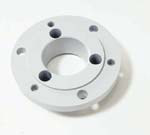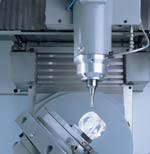
Ultrasonic Technology Helps Machine Hard Materials
Ultrasonic Technology Helps Machine Hard Materials
Unlike applications in medicine, inspection and parts cleaning where ultrasonic (high frequency sound) waves are applied directly, ultrasonic machining is a metalcutting process that is facilitated by ultrasonic technology. The process uses a diamond coated milling, boring or grinding tool, actuated by ultrasonic technology, that can impact a workpiece with a frequency of 20 kHz or 20,000 times per second.

The result is a system that can machine brittle materials such as ceramics, glass, silicon, graphite, composite materials and precious stones. Increasingly, workpieces made from these "advanced materials" are being specified in the medical, automotive, aerospace and optics industries.
It is the properties of these materials—low weight, chemical and thermal stability and wear resistance—that make them attractive for design engineers. But the very properties that make the composition of these materials attractive for selected applications make them a bear to machine with conventional metalcutting processes.

In operation,the system uses a high frequency electrical signal that is converted into oscillating mechanical motion through pizo-electric motors. A booster amplifies the oscillation amplitude.
The high frequency motion causes the diamond coated cutting tool to expand and contract in a pulsating manner at a rated frequency of 20 kHz or 20,000 cycles per second. Cutting takes place at the highest point of amplitude or expansion of the tool. The diamond grits, attached to the tool, collide with the surface of the workpiece. The material is broken up into very small particles.
In addition to the oscillation of the cutting tool, it is simultaneously rotated at speeds between 3,000 and 40,000 rpm. Rotation of the tool exposes the full cutting surface of the tool to maintain dimensional accuracy of the workpiece and serves double duty of removing cut particles from the work zone.
Machining is done wet. When the machine is used as a grinder, the tool/work interface is flooded. For drilling and milling operations, rinsing and cooling are done through the spindle. Water is used as the medium for all operations.
Key to the success of this machining process is the construction of the cutting tools. A proprietary binder system adheres the diamond grains to the tool body. Unique in this application is the need for the binder and grains to contract and expand as the tool oscillates.
These tools are specially developed and matched to the material so that the erosion of the diamond is in sync with the cutting requirements. If the tool sheds grit too quickly, tool life suffers. If it hangs onto the grit too long, machining efficiency and surface finish tolerances are negatively impacted. The company says this process can yield a five-fold increase in productivity compared with conventional machining methods and is capable of surface finishes of 0.2 micron roughness average.
Control of the ultrasonic process is automatic using a combination of two dynamic systems. An adaptive control monitors the tool to maintain optimal feed through the machining cycle. Acoustic control uses sound signatures generated in the cut to sense the cutting efficiency of the tool for high tolerance work.
Find a professional ultrasonic assisted machining application?
Click Altrasonic Assisted Machining to realize it !
© Copyright: 2025 Hangzhou Altrasonic Technology Co.,Ltd All Rights Reserved

IPv6 network supported
Scan to WhatsApp
